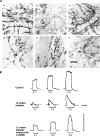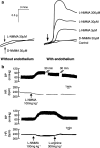The discovery of nitric oxide and its role in vascular biology
- PMID: 16402104
- PMCID: PMC1760731
- DOI: 10.1038/sj.bjp.0706458
The discovery of nitric oxide and its role in vascular biology
Abstract
Nitric oxide (NO) is a relative newcomer to pharmacology, as the paper which initiated the field was published only 25 years ago. Nevertheless its impact is such that to date more than 31,000 papers have been published with NO in the title and more than 65,000 refer to it in some way. The identification of NO with endothelium-derived relaxing factor and the discovery of its synthesis from L-arginine led to the realisation that the L-arginine: NO pathway is widespread and plays a variety of physiological roles. These include the maintenance of vascular tone, neurotransmitter function in both the central and peripheral nervous systems, and mediation of cellular defence. In addition, NO interacts with mitochondrial systems to regulate cell respiration and to augment the generation of reactive oxygen species, thus triggering mechanisms of cell survival or death. This review will focus on the role of NO in the cardiovascular system where, in addition to maintaining a vasodilator tone, it inhibits platelet aggregation and adhesion and modulates smooth muscle cell proliferation. NO has been implicated in a number of cardiovascular diseases and virtually every risk factor for these appears to be associated with a reduction in endothelial generation of NO. Reduced basal NO synthesis or action leads to vasoconstriction, elevated blood pressure and thrombus formation. By contrast, overproduction of NO leads to vasodilatation, hypotension, vascular leakage, and disruption of cell metabolism. Appropriate pharmacological or molecular biological manipulation of the generation of NO will doubtless prove beneficial in such conditions.
Figures






References
-
- ALDERTON W.K., ANGELL A.D.R., CRAIG C., DAWSON J., GARVEY E., MONCADA S., MONKHOUSE J., REES D., RUSSELL L.J., RUSSELL R.J., SCHWARTZ S., WASLIDGE N., KNOWLES R.G. GW274150 and GW273629 are potent and highly selective inhibitors of inducible nitric oxide synthase in vitro and in vivo. Br. J. Pharmacol. 2005;145:301–312. - PMC - PubMed
-
- ALMEIDA A., MONCADA S., BOLANOS J.P. Nitric oxide switches on glycolysis through the AMP protein kinase and 6-phosphofructo-2-kinase pathway. Nature Cell Biol. 2004;6:45–51. - PubMed
-
- CAI H., HARRISON D.G. Endothelial dysfunction in cardiovascular diseases: the role of oxidant stress. Circ. Res. 2000;87:840–844. - PubMed
-
- CELLEK S.1997Nitrergic and noradrenergic interaction in dually innervated organs of the genitourinary tractPhD Thesis. University of London
Publication types
MeSH terms
Substances
LinkOut - more resources
Full Text Sources
Other Literature Sources
Medical

